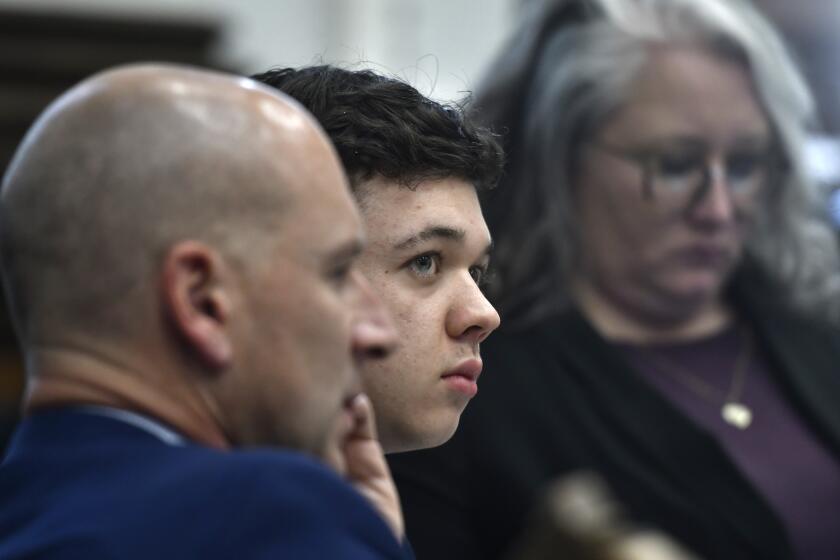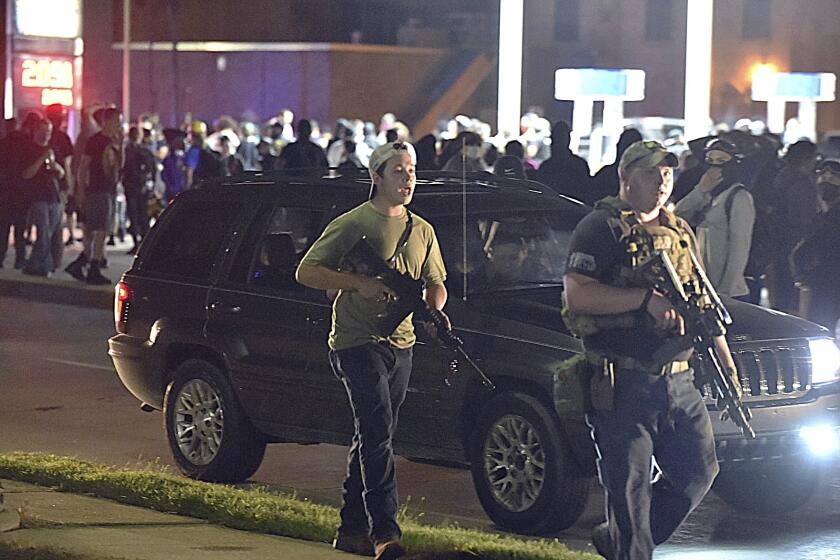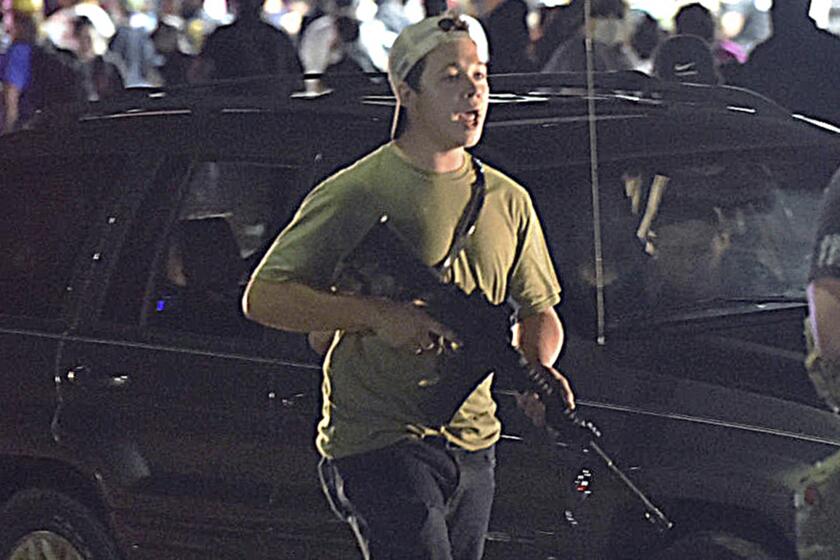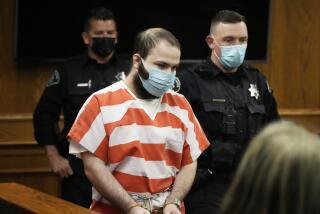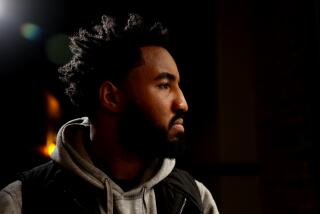‘I defended myself’: Kyle Rittenhouse testifies at Kenosha murder trial

Kyle Rittenhouse broke down in tears at his murder trial, testifying that he was being pursued by the first man he shot and killed in Kenosha, Wis.
- Share via
KENOSHA, Wis. — Kyle Rittenhouse testified Wednesday that he was under attack when he killed two men and wounded a third with his rifle during a chaotic night of protests in Kenosha, saying: “I didn’t do anything wrong. I defended myself.”
In a high-stakes gamble, the 18-year-old took the stand at his murder trial to tell his side of what happened on the streets that day last summer, sobbing so hard at one point that the judge called a break.
In an account largely corroborated by video and the prosecution’s witnesses, Rittenhouse said that the first man cornered him and put his hand on the barrel of Rittenhouse’s rifle, the second man hit him with a skateboard, and the third man came at him with a gun of his own.
His nearly all-day testimony was interrupted by an angry exchange in which his lawyers demanded a mistrial over what they argued were out-of-bounds questions asked of him by the chief prosecutor.
The judge, though plainly angry at the prosecutor, did not immediately rule on the request. Later, he instructed the jury to expect closing arguments early next week.
The jury at Kyle Rittenhouse’s murder trial over shootings at a Wisconsin protest watched one of the central pieces of video evidence Wednesday.
Rittenhouse is on trial over the shootings he committed during unrest that erupted in Kenosha over the wounding of Jacob Blake, a Black man, by a white Kenosha police officer. If convicted, he could get life in prison on the charges.
Rittenhouse, who was 17 at the time, went to Kenosha with an AR-style semiautomatic weapon and a medic bag in what the former police youth cadet said was an effort to protect property after rioters had set fires and ransacked businesses on previous nights.
The case has divided Americans over whether Rittenhouse was a patriot taking a stand against lawlessness or a vigilante.
As he began crying on the stand and appeared unable to speak, his mother, Wendy Rittenhouse, seated on a bench across the courtroom, sobbed loudly. Someone put an arm around her. After the judge called a recess, jurors walked by Rittenhouse and looked on as he continued to cry.
After the morning outburst, he was largely composed the rest of the day, though his voice seemed to break at times as he came under tough cross-examination.
Prosecutor Thomas Binger went hard at Rittenhouse, walking him through each of the shootings. Rittenhouse continually pushed back, saying he had no choice but to fire.
Rittenhouse said he “didn’t want to have to shoot” Joseph Rosenbaum, the first man to fall the night of Aug. 25, 2020, but he said Rosenbaum was chasing him and had threatened to kill him earlier.
An acquittal wouldn’t just set Rittenhouse free, it would set a legal precedent for other citizens to grab a gun and take the law into their own hands.
“If I would have let Mr. Rosenbaum take my firearm from me, he would have used it and killed me with it,” he said, “and probably killed more people.”
But Rittenhouse also acknowledged that the strap holding his gun was in place and that he had both hands on the weapon. And Binger suggested that Rosenbaum might have been trying to bat the rifle away.
The prosecutor sought to drive home the state’s contention that Rittenhouse created the dangerous situation in the first place.
“You understand that when you point your AR-15 at someone, it may make them feel like you’re going to kill them, correct?” Binger asked.
Rittenhouse testified that he then shot and killed protester Anthony Huber after Huber struck him in the neck with his skateboard and grabbed his gun. Then he wounded Gaige Grosskreutz, saying the protester had lunged at him “with his pistol pointed directly at my head.”
Rittenhouse’s decision to testify carried risks, including the possibility of fierce cross-examination. And some legal experts expressed doubt about the need to put him on the stand, given that some of the prosecution’s witnesses have already bolstered his claim of self-defense.
Much of the testimony Wednesday was centered on the shooting of Rosenbaum because that set in motion that bloodshed that followed.
Rittenhouse said that earlier that night, Rosenbaum was holding a chain and twice threatened his life. Apologizing to the court for his language, Rittenhouse quoted Rosenbaum as saying: “I’m going to cut your ... hearts out!”
Later that night, Rittenhouse said, he was walking toward a car dealer’s lot with a fire extinguisher to put out a blaze when he heard somebody scream, “Burn in hell!” He said he responded by saying, “Friendly, friendly, friendly!”
He said Rosenbaum was running at him from one side and another protester with a gun was in front of him, and he was cornered. He said he began to run, and he heard a protester tell Rosenbaum, “Get him and kill him!”
Rittenhouse said he heard a gunshot directly behind him, and as he turned around, Rosenbaum was coming at him with his arms out in front. “I remember his hand on the barrel of my gun,” Rittenhouse said.
States must be able to limit gun carry to promote the safety of the public square and protect the freedoms of assembly and speech.
That was when he fired, he said.
He also said he thought the object Rosenbaum threw during the chase — a plastic hospital bag — was the chain he had seen earlier.
Asked by his lawyer why he didn’t keep running away from Rosenbaum, Rittenhouse said: “There was no space for me to continue to run to.”
During cross-examination, Binger asked Rittenhouse about whether it was appropriate to use deadly force to protect property and also posed questions about the defendant’s silence after his arrest.
At that, the jury was ushered out of the room, and Circuit Judge Bruce Schroeder loudly and angrily accused Binger of pursuing an improper line of questioning and trying to introduce testimony that the judge earlier said he was inclined to prohibit — video made some 15 days before the shootings, in which Rittenhouse watches men leave a CVS pharmacy and is heard commenting that he wished he had his rifle so he could shoot them because he thought they were shoplifters.
Rittenhouse lawyer Corey Chirafisi all but suggested prosecutors were deliberately trying to cause a mistrial because the case is “going badly” for them and they want a do-over. The defense asked for a mistrial with prejudice, meaning that if one is granted, Rittenhouse cannot be retried.
When Binger said he had been acting in good faith, the judge replied: “I don’t believe that.”
As he first took the stand, Rittenhouse was asked by his attorney whether he came to Kenosha looking for trouble, and he responded no.
He testified that he saw videos of violence in downtown Kenosha on the day before the shootings, including a brick being thrown at a police officer’s head and cars burning in a Car Source dealership lot.
Rittenhouse said the Car Source owner “was happy we were there” that night.
More to Read
Sign up for Essential California
The most important California stories and recommendations in your inbox every morning.
You may occasionally receive promotional content from the Los Angeles Times.
